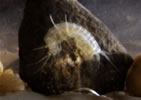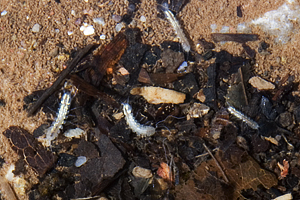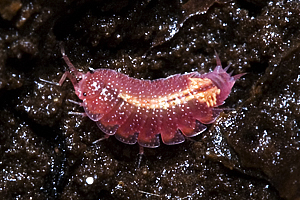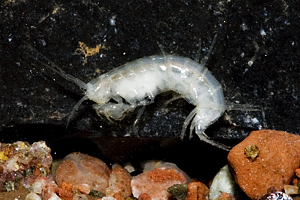 |
Cave Life of Wales |
 |
| |
| HOME |
| INTRODUCTION |
| LIFE IN THE ENTRANCE |
| LIFE IN THE CAVE |
| CONSERVATION |
| GLOSSARY |
| ACKNOWLEDGEMENTS |
| |
| Bacteria |
| Fungi |
| Plants, Algae & Protozoans |
| Sponges |
| Flatworms |
| Eelworms & Segmented Worms |
| Slugs & Snails |
| Crustacea |
| Insects |
| Spiders & Millipedes |
| Fish & Amphibians |
| Birds |
| Bats |
Life in the cave - Crustacea |
||||||
There are many representatives of this phylum found underground, often in water; some of them are particularly ancient and found only in caves. Ostracods mostly live in freshwater. They have a two part carapace (like a shell) but because they are small and difficult to identify there are few recordings, although one has been identified from Porth yr Ogof. One in Ogof Ffynnon Ddu appears to prefer flowstone covered with seepage water. A small variety of Copepods have been identified in Welsh caves. So far none are troglobites but one will probably be discovered one day. Three different species have been identified in Ogof Clogwyn. Because they are very small their importance in the underground ecosystem is probably underestimated. The troglobite Isopod Proasellus cavaticus is usually found in streams on the underside of stones, and on the thin film of water flowing over flowstone, and in pools. They are white, eyeless, up to 8mm long, look like undernourished woodlice and have been found in most of the major Welsh caves plus Porth yr Ogof, Ogof Clogwyn and Ogof y Ci. They appear to have the capacity to multiply quickly when food is plentiful - in Ogof Ffynnon Ddu 1 populations up to 80 per square m have been found on stalagmite slopes that are covered with a thin film of water and a heterotrophic bacterium. The silt and slimey brown film (consisting of filamentous bacteria and fungi) is probably their food source. They are often relatively inactive and so hard to spot. They are preyed on by the cave shrimp and some flatworms and may frequent steeper flowstone to avoid these predators. It is also found in the main streamway of Ogof Ffynnon Ddu but whether these have been washed in or live there is not clear.
Woodlice are often seen in Porth yr Ogof on the walls and amongst the rotting plant debris. The Common Shiny Woodlouse, Oniscus asellus, is common and has been identified from e.g. Ogof y Ci. Woodlice are usually near the thresholds of caves. One woodlouse, Androniscus dentiger, appears quite happy in the cave – it is a more delicate pink colour than the usual woodlouse and is frequently found under stones and in rotting piles of wood (and outside in your compost heap). It also has been found in the big systems and Porth or Ogof, Ogof y Ci and Llethrid Cave.
The Sea Slater (Ligia oceanica) is a relative of the woodlouse and is found on rocky coasts and in sea caves. It prefers shaded habitats and comes out after dark to forage for food. Amphipods, whose bodies are flattened laterally (sideways) include the shrimps. The troglobite cave shrimp, Niphargus fontanus, has been found in many Welsh caves and is widespread in the northern outcrop of South Wales. It lives in the flooded parts of caves as well as above the water table. It is an omnivore ingesting silt to extract organic matter as well as preying on Proasellus. They are fairly active and so easier to spot in pools and small streams. It is able to swim and hide in crevices and so can cope with living in a small stream that is liable to floods. They also seem to be able to leave their habitat if it dries up and return when it floods again.
Recent work has found specimens of the tiny shrimp Microniphargus leruthi in S Wales. There are few records from Britain but it has probably been overlooked due to small size (1.5 to 2mm). The freshwater shrimp commonly seen outside is Gammarus pulex. It does get washed into caves and like many other creatures left in the dark they eventually turn white. They are rare in the pools fed by seepage water alone. They are scavengers, browsing on microscopic plants, animals, and decomposing material. On the surface Gammarus are much more active at night than during the day hours. Where surface streams enter caves the washed in surface dwellers (e.g. Gammerus) seem to be able to outcompete the troglobites (e.g. Niphargus), so the troglobites are often found either deep in the cave or away from areas where their competitors might be e.g. in seepage areas rather than streams. So the best place to look for true troglobites like Niphargus is in pools and streams fed by seepage (often above the flood zone) and not the larger surface fed streams. Stalagmite flows and gour pools are a good place to look. Prawns (members of the Decapoda) have been seen in Otter Hole. Lobsters are probably quite at home in the dark zone of marine caves.
|


